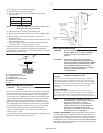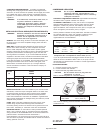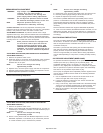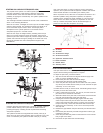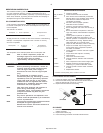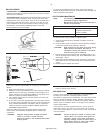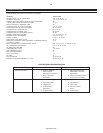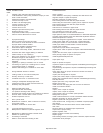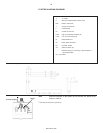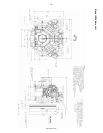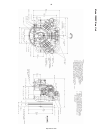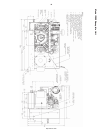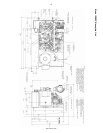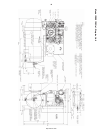
11
CHECK POSSIBLE CAUSE POSSIBLE SOLUTION
POINT
1 Clogged or dirty inlet and/or discharge line filter. Clean or replace.
2 Loose beltwheel or motor pulley, excessive end play in motor Check beltwheel, motor pulley, crankshaft, drive belt tension and
shaft or loose drive belts. alignment. Repair or replace as required.
3 Inadequate ventilation around beltwheel. Relocate compressor for better air flow.
4 Lubricant viscosity too low. Drain existing lubricant and refill with proper lubricant.
5 Air leaks in air discharge piping. Check tubing and connections. Tighten joints or replace as required.
6 Lubricant viscosity too high. Drain existing lubricant and refill with proper lubricant.
7 Lubricant level too high. Drain excess lubricant.
8 Lubricant level too low. Add lubricant to crankcase to proper level.
9 Detergent type lubricant being used. Drain existing lubricant and refill with proper lubricant.
10 Extremely light duty cycles. Run compressor for longer duty cycles.
Compressor located in damp or humid location. Relocate compressor or install crankcase heater kit.
11 Pressure switch differential too narrow. Adjust pressure switch to increase differential, if differential adjustment
provided. Install pressure switch with differential adjustment feature if
differential adjustment is desired.
12 Improper line voltage. Check line voltage and upgrade lines as required. Contact electrician.
Wiring or electric service panel too small. Install properly sized wire or service box. Contact electrician.
Poor contact on motor terminals or starter connections. Ensure good contact on motor terminals or starter connections.
Improper starter overload heaters. Install proper starter overload heaters. Contact electrician.
13 Poor power regulation (unbalanced line). Contact power company.
14 Drive belts too tight or misaligned. Adjust belts to proper tension and alignment.
15 Compressor valves leaky, broken, carbonized or loose. Inspect valves. Clean or replace as required. Install Valve/Gasket Step
Saver Kit.
16 Automatic drain valve clogged, leaking or defective. Inspect valve and clean, repair or replace as required.
17 Carbon build-up on top of piston(s). Clean piston(s). Repair or replace as required.
18 Piston rings damaged or worn (broken, rough or scratched). Install Ring/Gasket Step Saver Kit.
Excessive end gap or side clearance.
Piston rings not seated, are stuck in grooves or end gaps not Adjust piston rings.
staggered.
19 Cylinder(s) or piston(s) scratched, worn or scored. Repair or replace as required.
20 Connecting rod, piston pin or bearings worn or scored. Inspect all. Repair or replace as required. Install Bearing/Connecting Rod
Loose bearing spacer on crankshaft. Step Saver Kit.
21 Defective ball bearings on crankshaft or motor shaft. Inspect bearings and replace if required. Install Bearing/Connecting Rod
Step Saver Kit.
22 Wrong beltwheel direction of rotation. Check motor wiring for proper connections. Reverse two leads on
three-phase motors.
23 Leaking, broken or worn inlet unloader parts. Inspect parts and replace as required.
24 Auxiliary valve dirty or seats worn. Inspect parts. Clean, adjust or replace as required.
25 Crankshaft seal worn or crankshaft scored. Replace seal. Install shaft sleeve if required. Install Bearing/Connecting
Rod Step Saver Kit.
26 Leaking or maladjusted centrifugal pilot valve. Replace pilot valve o-ring. Adjust pilot valve.
27 Leaking check valve or check valve seat blown out. Replace check valve.
28 Extremely dusty atmosphere. Install remote air inlet piping and route to source of cleaner air.
Install more effective filtration.
29 Defective safety/relief valve. Replace.
30 High pressure inlet valve leaking. Inspect, clean or repair as required.
31 Low pressure discharge valve leaking. Inspect, clean or repair as required.
32 Automatic start and stop mode is not suitable for air demand. Adjust auxiliary valve for constant speed operation
33 Pressure switch unloader leaks or does not work. Realign stem or replace.
34 Ambient temperature too low. Install crankcase heater kit. Convert to All-Season Select
®
lubricant.
Relocate compressor to warmer environment.
35 Worn cylinder finish. Deglaze cylinder with 180 grit flex-hone.
36 Beltwheel out of balance, tubes not braced or secured, Check vibration level, change pulley or beltwheel if required, tighten
wrong pulley speed. tube clamps.
37 Excessive condensate in receiver tank. Drain receiver tank with manual drain valve or install automatic
drain valve.
38 Loose fittings/elbows/connectors Re-torque fittings per specified torque requirements
39 Maladjusted or defective oil pressure regulator valve Adjust valve to proper setting
Replace regulator valve
40 Maladjusted or defective hydraulic unloader valve Replace hydraulic unloader valve assembly
41 Defective oil pressure gauge Replace gauge
42 Oil foaming in crankcase Drain existing lubricant, thoroughly clean crankcase, replace lubricant
43 Debris or other obstruction blocking oil flow Inspect/clean all oil passages
http://air.irco.com



